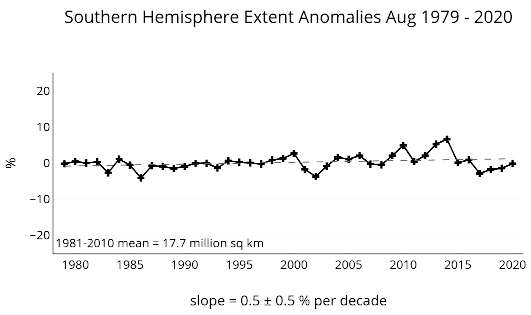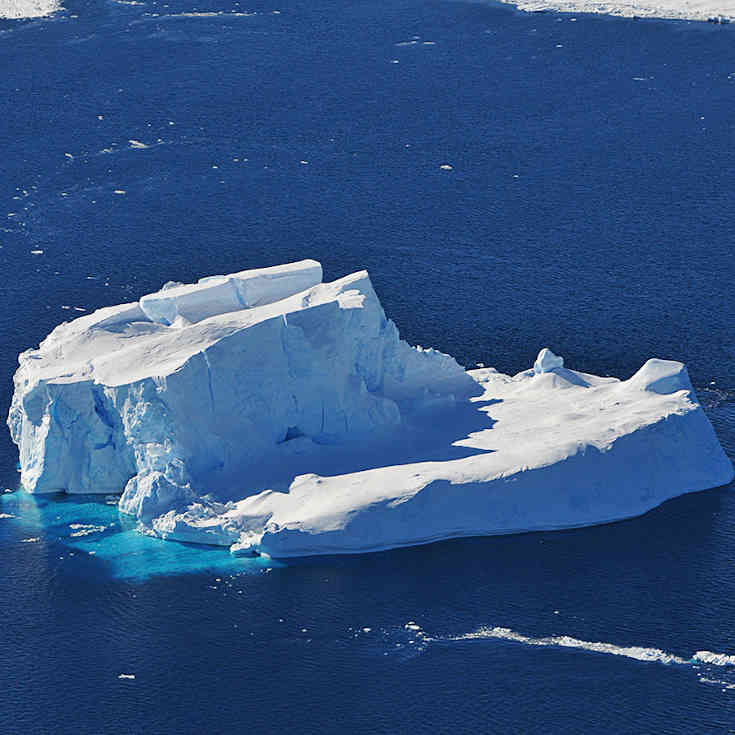Claim
Craig Kelly said on 31 August: “‘GLOBAL’ WARMING ? We’ll [sic] certainly not down in the Antarctic.”
Verdict

Misleading and inaccurate. Mr Kelly has selected a small part of the data. The full dataset shows that ice is melting in Antarctica, just more slowly and variably than elsewhere.
Why this verdict?
Craig Kelly has displayed a graph which shows that the extent of Antarctic sea ice this year is above the recent average. Thus, he suggests, maybe global warming isn’t happening – or at least not in the Antarctic.
There are three reasons why his statement is misleading.
1. Cherry picking data
Sea ice is ice that floats on top of the ocean. It covers a greater area in winter and a lesser area in summer. There is sea ice in both the Arctic and Antarctic.
It is well known that the climate is dynamic, with variations year to year because of different ocean currents and other factors. To get a fair idea of what is happening, we need to look at a reasonable period of time.
When we do this for Antarctic sea ice, we find that Craig Kelly’s fact has been carefully selected.
The records show that over the last 40 years:
- overall, sea ice in the Antarctic was increasing slowly up to 2016;
- the maximum extent was also increasing, but the minimum extent was decreasing;
- all measures showed a major reduction in sea ice for the period 2017-2019, and;
- 2020 so far has seen a return to almost normal levels.

From the graphs, it appears that August 2020 was the first time in the last 4 years that the extent of Antarctic sea ice has been above average.
We cannot draw a conclusion from one month. It is simply too soon to know if there is any trend.
2. Global means global
“Global warming” means that the earth as a whole is warming. There will be variations. If it is colder in one place, it will be warmer somewhere else.
No-one who understands global warming thinks that a cold day in one place is evidence against warming. The question is, what is happening overall?
Over the same period that Antarctic sea ice has been increasing at a rate of about 0.5% per decade, sea ice in the Arctic has been retreating at a much greater rate (12.85% per decade).
So globally, sea ice extent is disappearing at an alarming rate, and this is consistent with global warming.
3. Ignoring data
Sea ice isn’t the only indicator of climate.
Other data also show the effects of global warming on Antarctica.
- The Antarctic is getting warmer overall, with some parts warming fast and others showing either mild warming or mild cooling. Several record high temperatures have been recorded in the past year.
- The ice sheets covering most of Antarctica’s land mass show a similar pattern, with significant loss of ice in some sections, very little loss in others, and even a slight gain in some areas. Overall, there has been a large and alarming loss of ice.
- The upper layers of the oceans around Antarctica are warming.
Conclusion
Climate varies so much that it is always possible to cherry pick a time and place that is colder than normal. But the overall picture consistently shows that global sea ice is declining and Antarctica is warming.
Global warming is happening.
References
- Understanding climate: Antarctic sea ice extent. NOAA Climate.gov.
- Current State of Sea Ice Cover. NASA Earth Sciences.
- Antarctic Daily Image Update. National Snow and Ice Data Center.
- Greenland, Antarctica Melting Six Times Faster Than in the 1990s. NASA. This was before the current increase in Antarctica.
- Antarctica is colder than the Arctic, but it’s still losing ice. NOAA climate.gov.
Photo: Iceberg in the Antarctic (NASA).
